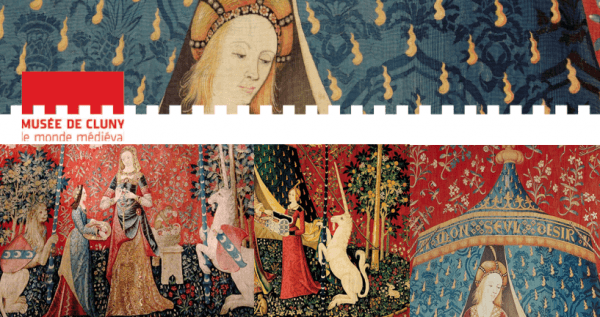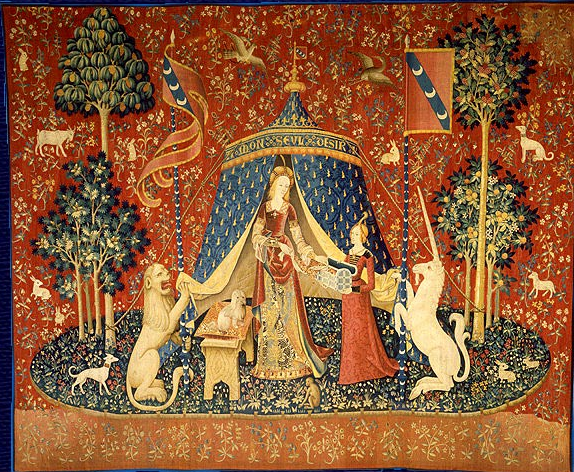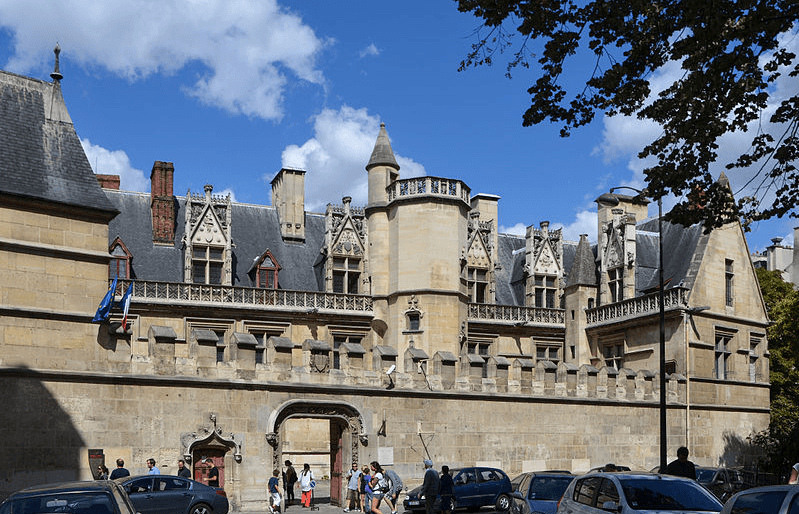
Posted in Events le 27 February 2014
The mysterious Lady and the Unicorn restored
After a nearly two-year renovation and thorough cleaning, “The Lady and the Unicorn” tapestries are back at the Musée National du Moyen Age. The Musée de CLuny is conveniently located five minutes walking distance from our hotel the Villa d'Estrées and the Résidence des Arts. The famous tapestries were discovered in 1841 in the Chateau de Baussac and made famous by writer George Sand. Some call it the Mona Lisa of tapestry and it has inspired novels and songs, it was even featured in Harry Potter movies.
 The six tapestries depict a slender, blond woman in a Mediterranean garden with a unicorn and a lion on either side. They were woven in Flanders in the early 1500s by unknown artisans. They are considered some of the finest examples of medieval handiwork. The beauty of these pieces is beyond dispute and now that they have been restored they are more luminous than ever. The room where it is exposed has also been revamped to enhance the appreciation of this masterpiece.
Historians say that the tapestries depict the five senses.
- touch: the woman holds the unicorn’s horn and a flag
- taste: the woman feeds a bird
- smell: she holds flowers
- hearing: she plays music
- sight: she shows the unicorn his reflection in a mirror
The sixth is still being debated upon. The title is "A mon seul désir", meaning "to my only desire". Some historians believe it represents the heart, the sixth and innermost sense. The most often quoted significance is the refusal of temptation, and the renunciation of the five senses. Some also argue that in five of the six panels, the mysterious lady is Mary Tudor, third wife of Louis XII and sister of Henry VIII, who was Queen of France in 1514. Much mystery continues to surround those tapestries!
The six tapestries depict a slender, blond woman in a Mediterranean garden with a unicorn and a lion on either side. They were woven in Flanders in the early 1500s by unknown artisans. They are considered some of the finest examples of medieval handiwork. The beauty of these pieces is beyond dispute and now that they have been restored they are more luminous than ever. The room where it is exposed has also been revamped to enhance the appreciation of this masterpiece.
Historians say that the tapestries depict the five senses.
- touch: the woman holds the unicorn’s horn and a flag
- taste: the woman feeds a bird
- smell: she holds flowers
- hearing: she plays music
- sight: she shows the unicorn his reflection in a mirror
The sixth is still being debated upon. The title is "A mon seul désir", meaning "to my only desire". Some historians believe it represents the heart, the sixth and innermost sense. The most often quoted significance is the refusal of temptation, and the renunciation of the five senses. Some also argue that in five of the six panels, the mysterious lady is Mary Tudor, third wife of Louis XII and sister of Henry VIII, who was Queen of France in 1514. Much mystery continues to surround those tapestries!
 ©pline
The Musée National du Moyen Age is housed in the Hôtel de Cluny, one of only two remaining medieval homes in Paris (the other is the Hôtel de Sens in the Marais). The building was founded by the rich and powerful 15th-century abbot of Cluny Abbey, Jacques d'Amboise, who constructed his mansion over the ruins of a Roman bath. The courtyard is a perfect architectural example of 16th century design. The Roman Baths date to 200 AD and you can also enjoy a beautiful medieval garden.
Musée de Cluny
6 place Paul Painlevé 75005 Paris
Open everyday except tuesdays from 9:15am to 5:45pm
http://www.musee-moyenage.fr/
©pline
The Musée National du Moyen Age is housed in the Hôtel de Cluny, one of only two remaining medieval homes in Paris (the other is the Hôtel de Sens in the Marais). The building was founded by the rich and powerful 15th-century abbot of Cluny Abbey, Jacques d'Amboise, who constructed his mansion over the ruins of a Roman bath. The courtyard is a perfect architectural example of 16th century design. The Roman Baths date to 200 AD and you can also enjoy a beautiful medieval garden.
Musée de Cluny
6 place Paul Painlevé 75005 Paris
Open everyday except tuesdays from 9:15am to 5:45pm
http://www.musee-moyenage.fr/
 The six tapestries depict a slender, blond woman in a Mediterranean garden with a unicorn and a lion on either side. They were woven in Flanders in the early 1500s by unknown artisans. They are considered some of the finest examples of medieval handiwork. The beauty of these pieces is beyond dispute and now that they have been restored they are more luminous than ever. The room where it is exposed has also been revamped to enhance the appreciation of this masterpiece.
Historians say that the tapestries depict the five senses.
- touch: the woman holds the unicorn’s horn and a flag
- taste: the woman feeds a bird
- smell: she holds flowers
- hearing: she plays music
- sight: she shows the unicorn his reflection in a mirror
The sixth is still being debated upon. The title is "A mon seul désir", meaning "to my only desire". Some historians believe it represents the heart, the sixth and innermost sense. The most often quoted significance is the refusal of temptation, and the renunciation of the five senses. Some also argue that in five of the six panels, the mysterious lady is Mary Tudor, third wife of Louis XII and sister of Henry VIII, who was Queen of France in 1514. Much mystery continues to surround those tapestries!
The six tapestries depict a slender, blond woman in a Mediterranean garden with a unicorn and a lion on either side. They were woven in Flanders in the early 1500s by unknown artisans. They are considered some of the finest examples of medieval handiwork. The beauty of these pieces is beyond dispute and now that they have been restored they are more luminous than ever. The room where it is exposed has also been revamped to enhance the appreciation of this masterpiece.
Historians say that the tapestries depict the five senses.
- touch: the woman holds the unicorn’s horn and a flag
- taste: the woman feeds a bird
- smell: she holds flowers
- hearing: she plays music
- sight: she shows the unicorn his reflection in a mirror
The sixth is still being debated upon. The title is "A mon seul désir", meaning "to my only desire". Some historians believe it represents the heart, the sixth and innermost sense. The most often quoted significance is the refusal of temptation, and the renunciation of the five senses. Some also argue that in five of the six panels, the mysterious lady is Mary Tudor, third wife of Louis XII and sister of Henry VIII, who was Queen of France in 1514. Much mystery continues to surround those tapestries!
 ©pline
The Musée National du Moyen Age is housed in the Hôtel de Cluny, one of only two remaining medieval homes in Paris (the other is the Hôtel de Sens in the Marais). The building was founded by the rich and powerful 15th-century abbot of Cluny Abbey, Jacques d'Amboise, who constructed his mansion over the ruins of a Roman bath. The courtyard is a perfect architectural example of 16th century design. The Roman Baths date to 200 AD and you can also enjoy a beautiful medieval garden.
Musée de Cluny
6 place Paul Painlevé 75005 Paris
Open everyday except tuesdays from 9:15am to 5:45pm
http://www.musee-moyenage.fr/
©pline
The Musée National du Moyen Age is housed in the Hôtel de Cluny, one of only two remaining medieval homes in Paris (the other is the Hôtel de Sens in the Marais). The building was founded by the rich and powerful 15th-century abbot of Cluny Abbey, Jacques d'Amboise, who constructed his mansion over the ruins of a Roman bath. The courtyard is a perfect architectural example of 16th century design. The Roman Baths date to 200 AD and you can also enjoy a beautiful medieval garden.
Musée de Cluny
6 place Paul Painlevé 75005 Paris
Open everyday except tuesdays from 9:15am to 5:45pm
http://www.musee-moyenage.fr/


